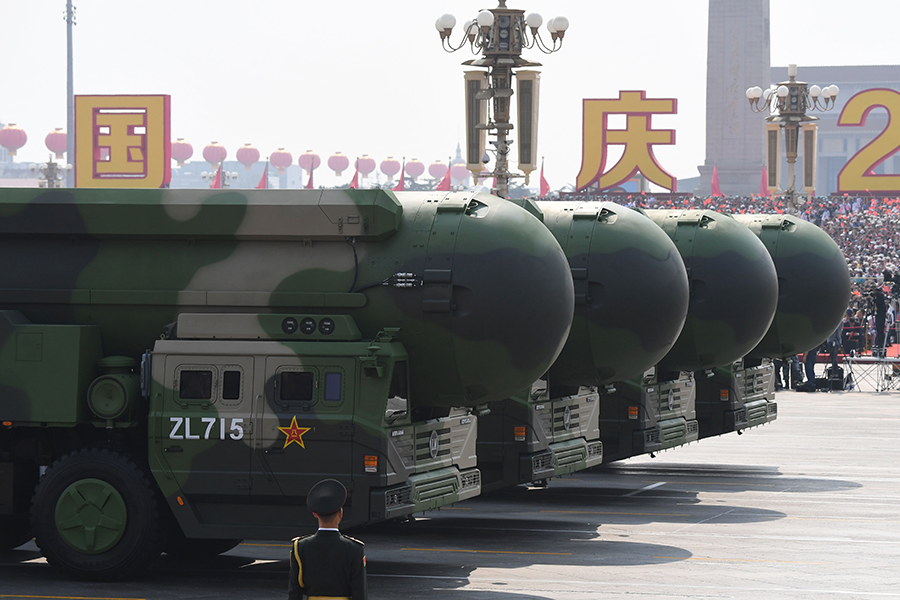Despite rising and imminent threats from Russia and China, the Biden Administration is pursing a unilateral course of limiting America’s deterrent.
Recently, the U.S. Department of Defense cancelled a test of an advanced missile, out of concern that it would “provoke Russia.” In response, Moscow test-launched one of its advanced Sarmat intercontinental ballistic missiles, also known as “Satan 2.” The Russian defense ministry reported that the long-range missile test began in western Russia, north of Moscow, and landed on the Kamchatka Peninsula in the country’s far east. It has unprecedented power.
The White House has also announced that it would no longer test America’s Anti-satellite (ASAT) weaponry. Neither China nor Russia has followed suite.
The move is consistent with the President’s other ill-advised defense moves.
While China has dramatically increased the size of its navy, and continues to build more warships, the Biden defense budget proposal would reduce the size of America’s navy. U.S. Representatives Mike Rogers (R-AL), Ranking Member of the House Armed Services Committee, and Rob Wittman (R-VA), Ranking Member of the Subcommittee on Sea Power and Projection Forces noted that “China is the pacing threat – this is something we’ve consistently heard from our military Commanders. However, it seems that President Biden has chosen to once again ignore his military advisors to the detriment of our Navy and Marine Corps’ readiness. The Biden administration’s 30 year shipbuilding plan reduces our ability to protect our aircraft carrier strike groups, reduces Navy’s ability to eliminate an enemy’s minefield, reduces the Marine Corps ability to conduct forcible entry missions and reduces almost 10% of our fleet’s ability to launch missiles. Most disconcerting is that the administration may have known the depths of these reductions and decided to not provide Congress with this information, hiding it with a one year shipbuilding plan presented to Congress last year. It takes years to build a ship and we no longer have the industrial strength we had during WWII to nearly instantaneously produce thousands of ships in times of conflict. Reducing our naval power to save a couple of dollars now puts our warfighters in a dangerous and incurable position when faced with China’s growing naval power.”
It’s more than missiles and ships. As Russia ravages Ukraine and China prepares to conquer Taiwan, the White House seeks to slash the U.S. army. The Army Times reports that “the Biden administration’s fiscal 2023 budget request would temporarily shrink the active duty Army to 473,000 troops…That could leave the service at its smallest size since 1940, when it had just over 269,000 troops.”
As Russia and China dramatically modernize their strategic nuclear weaponry and China engages in a rapid increase in the size of its force, America’s atomic deterrent dissolves into obsolescence. The Biden Administration has slow-walked a review that would outline the challenge and respond to the deadly threats now faced. Indeed, it continues to push for an Iranian nuclear deal that would only add to that threat.
Members of Congress have desperately complained. Rep. Scott DesJarlais (R-TN) worries that “For the second year in a row, the White House’s proposed defense budget fails to keep up with soaring inflation levels. …[and] weakens our national defense by reducing the size of our Army, Navy and Marine Corps, cutting funding for new nuclear deterrent capabilities, and reducing our ships and aircrafts. This signals to our adversaries and allies that our country is weak and unwilling to defend itself or protect our allies.”
This is not the usual Washington wrangling over marginal changes in a portion of the federal budget. Indeed, an entire weapons system, the sea launched cruise missile has been entirely eliminated. Ignoring the reality of an exceptional increase in the threat level combined with the devastating effect of inflation on American defense programs, it is an unprecedented and reckless assault on the security of the nation.
Photo: China’s DF-41 nuclear-capable intercontinental ballistic missiles
